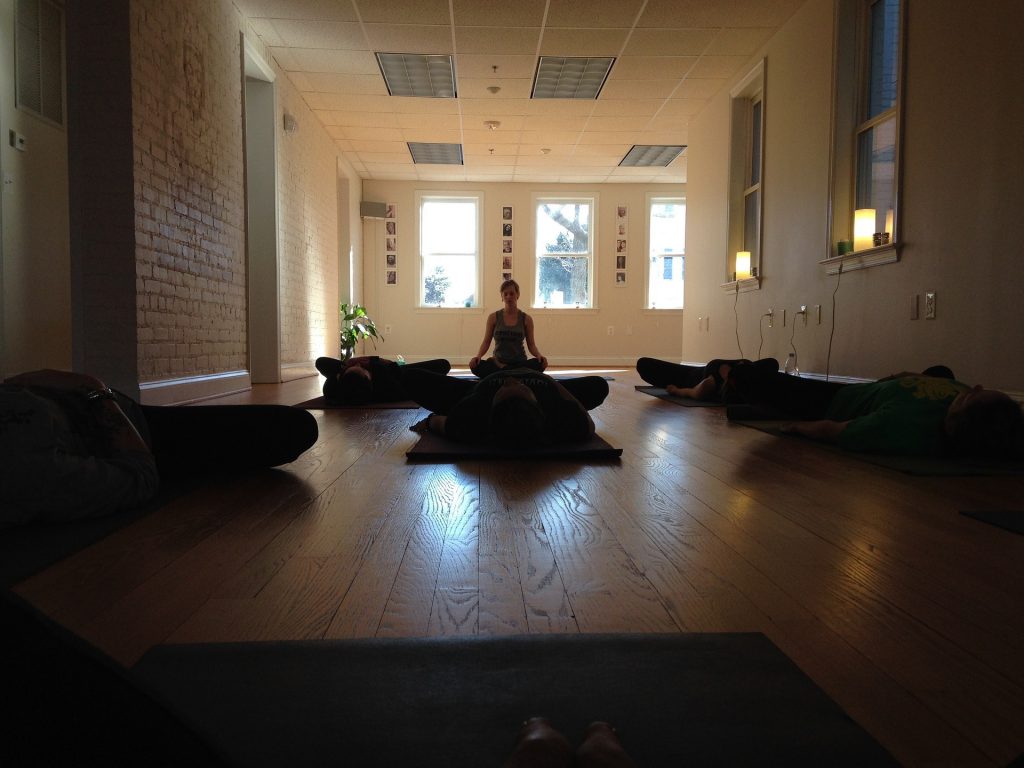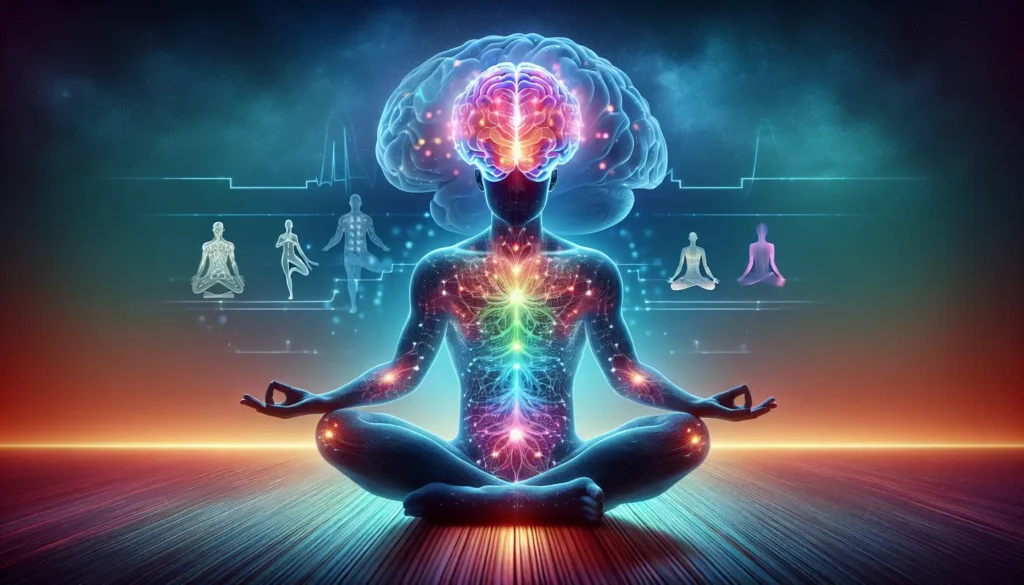In these turbulent times, our bodies and minds are tense and full of anxiety and worry. Perhaps you are struggling with stress or restless sleep? Discover Yoga Nidra meditation – your gateway to unparalleled relaxation and mental clarity. This practice, also called yogic sleep, bridges relaxation with conscious awareness. This allows you to unwind and recharge in ways conventional meditation does not.
Gain insight into this rejuvenating experience as we outline its principles, benefits, and the simple steps to get started with Yoga Nidra meditation.
Essential Insights
Yoga Nidra, also known as yogic sleep, is a transformational meditation practice that induces a state of deep relaxation between waking and sleeping, helping to alleviate physical, mental, and emotional tension.
Scientific research supports the benefits of Yoga Nidra, showing it improves emotional self-regulation, reduces anxiety and stress, and offers physiological benefits such as lowering cortisol levels, enhancing sleep, and potentially aiding in conditions like chronic pain and heart disease.
Practicing Yoga Nidra involves creating a calm environment, guided meditation, breath awareness, and setting a personal intension (known as a sankalpa), with tools such as iRest adapting traditional methods for modern applications in healthcare, military, and education settings.
The Essence of Yoga Nidra Meditation

Yoga Nidra is an ancient practice that invites your innate intelligence and clarity of awareness to rise to the surface of your consciousness.
It's a method of meditation for harnessing your innate wisdom.
Yoga Nidra is a gem in the world of yoga. It is often referred to as yogic sleep — a state of consciousness that lies on the cusp of waking and sleeping. Except it's a conscious sleep…as opposed to unconscious sleep. You are deeply relaxed and “asleep”, but fully aware, expanded, and conscious of what's happening to you.
Here, in the embrace of deep relaxation, you touch a realm beyond the ordinary, accessing a sanctuary of peace and understanding. It is a transformative experience that steadies your mind, awakens your heart, and alleviates tension on all levels: physical, mental and emotional.
The beauty of Yoga Nidra lies in its simplicity and power. Through guided meditation and breath awareness, it peels away the layers of stress and allows a profound connection with our innate intuitive awareness. This practice invites a journey to our true nature, where joy and peace are not just concepts, but tangible experiences
You consciously learn to place your mind in deep rest so that you can pay attention to the wisdom of your inner self and subconscious mind.
Origins and Philosophy of Yoga Nidra
Tracing back to ancient India, the roots of Yoga Nidra are as profound as they are ancient. This sacred practice emerged as a method of including deep relaxation to prepare the mind for the higher states of meditation found in classical yoga and the tantric traditions. The Upanishads, rich texts that explore the nature of self and consciousness, mention Yoga Nidra, tying it to the quest for self-knowledge and understanding of the soul.
In the tantric tradition, Yoga Nidra was a pathway to spiritual liberation, employing ritual and visualization to transcend the physical realm. The Hatha Yoga Pradipika, a classical text, echoes this, emphasizing relaxation, concentration, and visualization–elements essential to both Yoga Nidra's modern expression, making it a comprehensive practice for those seeking deep relaxation and self-inquiry.
Yogic Sleep vs. Traditional Meditation

Yoga Nidra stands distinct from traditional meditation practices. While meditation often involves sitting upright and actively concentrating, Yoga Nidra allows you to lie down in savasana, the posture of total relaxation, and be guided into a state of conscious awareness between waking and sleeping.
This unique state, where the body is deeply relaxed yet the mind is aware, can be more accessible and less daunting than the centered attentiveness required for traditional meditation.
Moreover Yoga Nidra introduces the concept of sankalph – an intention set at the beginning of the practice. This personal resolution serves as a seed planted in the fertile soil of the relaxed mind, with the potential to create significant shifts within personal patterns and behaviors. It's a practice that not only relaxes deeply but also empowers you to transform your life from the inside out.
The Science Behind Yoga Nidra

Stepping into the domain of science, we find that Yoga Nidra's benefits are not just anecdotal but are baked by research. Studies have shown that this practice can improve emotional self-regulation, reduce symptoms of anxiety, depression, and stress, and enhance overall quality of life. In particular, research published in the International Journal of Yoga highlights Yoga Nidra's effectiveness in reducing anxiety more than traditional meditation.
The physiological impact of Yoga Nidra is also impressive. It is associated with reductions in stress hormones like cortisol, mitigating the risk factors for a range of conditions including:
- inflammation
- heart disease
- sleep disorders
- chronic pain
It is clear that this ancient practice provides modern solutions to some of today's most pressing health challenges.
Brain Waves and the Hypnagogic State
Diving deeper into the science, we learn that the state of relaxation achieved through Yoga Nidra is mirrored in our brain wave activity. As you enter Yoga Nidra, your brain waves slow down, transitioning from the alert Beta waves to the relaxed Alpha and Theta waves often found in the early stages of sleep, and in more experienced practitioners, to the Delta waves of deep sleep.
This shift to slower brain wave activity facilitates entry into the hypnagogic state, a liminal space where one remains coscious amidst the onset of sleep's deep relaxation. Regular engagement with Yoga Nidra not only helps you fall asleep but also enriches sleep quality and enhances cognitive functions, optimizing brain processing speed and accuracy.
Moreover, these deeper brainwave states create a natural environment for meditation, easing the practitioner into a meditative experience without the need for concentrated effort.
Yoga Nidra Health Benefits
The health benefits of Yoga Nidra include:
- Improved sleep quality and duration, making it a therapeutic alternative for those battling insomnia.
- More effective than traditional meditation for anxiety and stress relief
- Increased alpha wave frequency in the brain, which has been correlated with reduced symptoms of anxiety and depression.
Furthermore, Yoga Nidra's impact on brain wave activity may contribute to migraine relief, and forms or the practice like iRest have shown benefits in treating conditions such as PTSD, depression, and anxiety.
For those with rheumatoid arthritis, Yoga Nidra has even been researched as a method for significant pain relief, addressing the multifaceted nature of chronic pain.
Psychological Benefits
Relaxing, accepting, and opening to life train the mind to become more focused and in tune with unseen forces.
Yoga Nidra releases seated anxieties in the mind and reduces stress levels. Each one of us stores our fears and worries at a subconscious level.
Practicing Yoga Nidra gives you the opportunity to release your fears from your unconscious mind so you are no longer shackled by them.
Spiritual Benefits
We go through our daily activities as mere observers, passive and out of touch.
Yoga Nidra helps you connect to your heart, and what's true for you. This gives you the freedom to live your life more authentically, as who you really are. You feel more connected to yourself and everything that goes on around you, enabling you to be present in the unfolding moment.
In fact, perhaps the best benefit of Yoga Nidra is the ability to perceive differently and gain control of your mindset. You can train your mind to alter your entire outlook on life for the better.
According to Rod Stryker, the founder of Para-Yoga, and author of The Four Desires… The practice of Yoga Nidra allows you to view yourself in the most positive light.
Practicing Yoga Nidra: Techniques and Tips

Now that we've explored the what and why of Yoga Nidra, let's focus on the how.
Practicing Yoga Nidra meditation is an art that involves preparation, from setting the stage to following guided meditation protocols and establishing a personal intention. Whether you are a first-timer or seeking to deepen your existing practice, these techniques and tips will serve as your compass to navigate the tranquil waters of yogic sleep.
Setting the Stage
To immerse fully in Yoga Nidra, creating the right environment is crucial. Here are some steps to follow:
- Find a quiet space, as it allows you to drop into a state of rest and relaxation without distractions.
- Find your posture; typically this means lying down in savasana, but any reclining position that maintains comfort throughout the session will work.
- Use props like cushions or blankets to help tailor the practice to your body's needs, ensuring accessibility and comfort for all.
By following these steps, you can create the perfect environment for your Yoga Nidra practice.
Guided Meditation and Breath Awareness
Breath awareness is at the heart of Yoga Nidra, guiding the practitioner into deeper states of relaxation. By focusing on the breath, you tether your attention to the present, allowing the mind to settle without the need to alter the natural rhythm of your breathing. Visualization can play a supportive role here, where you might picture the breath flowing through your body, or even mentally count your breaths to deepen focus.
This heightened awareness of the breath – particularly the rise and fall of the abdomen, supports a more profound relaxation, ensuring the mind remains awake while the body succumbs to restfulness. Monitoring heart rate variability can also provide valuable insights into one's relaxation levels.
Sankalpa: Setting an Intention
A sankalpa, or intention, is a powerful tool in Yoga Nidra. It is a resolution that reflects a deep desire of life's goal, acting as a compass guiding you towards fulfillment.
To create a strong sankalpa, it should be concise, positive and framed in the present tense-like a promise you make to yourself This intention is affirmed mentally at the beginning of your practice, planting it deeply into your subconscious, ready to blossom into reality.
Additionally, identifying an inner resource–a mental refuge of peace and security, can enhance the power of your sankalpa, providing the support needed to cultivate and realize your heartfelt desires.
How to Practice Yoga Nidra
Yoga Nidra is practiced with either an audio recording, or with a teacher or facilitator who guides you through several levels or stages of concentration. Most recordings last 30 minutes on average… And even though 30 minutes may sound like a lot, you'll soon find out there's no better way to maximize your hidden potential, recharge, and re-align your body, mind, and soul.
If you already have a regular physical workout routine or yoga practice, try ending it with a Yoga Nidra session.
Some people find that practicing Yoga Nidra at night helps them to drift into sleep. Find what works best for you. I like to practice in the evening after work to clear my headspace and get ready for sleep.
The following is a basic Yoga Nidra script. It's much easier to follow a guided session so you can fully immerse yourself in the process.
Getting Ready Steps
Get Comfortable
Have a blanket to keep you warm and, if possible a bolster for your low back and knees
Connect To Your Intention
Bring to mind your deepest desire… Whatever you are aiming to create in life. Bring it to mind and then drop it down into your heart.
Feel as if it were already true. Speak it out loud if possible.
Then you will be asked to let go by engaging your power of surrender.
Becoming Aware of the Inside World
Be Aware of Your Body
Get in touch with your body, how you are feeling, what you are thinking. Notice anything you are taking in through one of your 5 senses… Then let them go.
Embrace Your Emotions
Yoga Nidra gives you the freedom to welcome all emotions within you, good and bad.
Without changing anything or thinking about what others might say or think. You're appreciating all your emotions which gives you a sense of inner quietness and composure.
Embrace Your Thoughts
Just as you witnessed your emotions, it's also important to welcome your thoughts. This includes your memories and mental images.
Even fleeting thoughts are vital and leave some kind of mark on your subconscious mind.
Don't judge your thoughts or emotions, just notice them.
Be Aware of Your Thoughts
Picture your body breathing on its own. Notice how the air flows in and out through your nose, throat, lungs, and diaphragm. Take slow relaxing breaths and sense the rhythmic movement of your belly rising and falling as each breath goes in and out. More importantly, feel how your breathing gives your body energy and life.
Yoga Nidra Begins
Countdown Breaths
Start with the number '40' and coordinate your breath counting backward to 1. Inhale while mentally saying 40, exhale '39'. The next inhale is '38', and the next exhale is '37'… Keep going till you get to 1. If you forget where you are, it's okay.
Just feel yourself relaxing deeply with each exhale and you count from 40 to 1.
Progressively Relax Your Muscles
The audio instructions will guide you to consciously focus on different parts of your body. There are different sequences or progressions that take you from location to location within your body. Organs, muscles, joints, skin, and more… Simply follow the instructions and go with it.
Bring in Light
As you move through the sequence, you will be prompted to imagine your awareness as a golden light touching each part of your body. It saturates your entire body, heart, and mind with golden soothing light. Finally, when you are filled, you send out that light to everyone you know… Family, friends, everyone you know, and finally to all beings everywhere. Continue giving and receiving; let your sense of personal self start to dissolve. Bask in the sensation.
Closing the Practice
Take in Some Final Breaths
Bring your awareness back to your breath. Don't overthink it, just experience the moment. Let your breath hold you. At this point, you may be asked to bring your intention back to your awareness on an in-breath and let it go again on the out-breath. Return to your natural breath.
More on Alternate Nostril Breathing here
Close the Practice
Wiggle your fingers and toes. Start to move your body around. Notice where you are and the time. Do you feel energized and awake? Open and loving? Has your awareness changed? Open your eyes and come back to life.
Integrative Restoration: A Modern Approach to Yoga Nidra

As Yoga Nidra continues to evolve, it welcomes adaptations like iRest, Integrative Restoration, a contemporary version that weaves mindfulness and Western psychology into the traditional 10-step protocol. iRest is designed to be flexible, suitable for personal practice or teaching, and can be practiced in full or in parts, accommodating the needs and experiences of the practitioner.
The foundational steps of iRest lay the groundwork for practice, while the complete 10-step protocol invites a deeper self-exploration and understanding, leading to tranquility and equanimity.
iRest Principles and Practices
The iRest framework is a roadmap to inner peace. The first five steps are perfect for beginners, with the subsequent steps introduced as one gains experience. Steps four and five involve engaging with the physical sensations and the breath, inviting grounding and stability into the practice.
The next stages of iRest include:
- Welcoming emotions and thoughts
- Fostering emotional regulation and insight into personal identity
- Reflection on the inner peace experienced during the session, encouraging the integration of this serenity into everyday life.
Applications in Healthcare and Beyond
The versatility of iRest becomes apparent in its various applications. In military settings, it has shown positive outcomes in treating PTSD and sleep disturbances among service members and combat veterans. A mobile health platform has even delivered iRest-based interventions, providing its scalability and effectiveness in improving sleep.
In schools, iRest has been incorporated into curricula to aid students and teachers in managing stress and balancing emotions, with specific certification programs available for educators. Its cognitive benefits and impact on sleep quality also suggest potential as an intervention for mild learning disabilities or cognitive impairments.
Yoga Nidra Resources: Books, Audio Recordings, and Workshops

Embracing Yoga Nidra is a journey, and having resources to guide you can be invaluable. From books that lay down foundational knowledge to audio recordings that lead you through guided sessions, there's a wealth of material at your fingertips.
If you're looking for a more immersive experience, workshops and retreats can offer deep rest, reflection, and rejuvenation.
Tops Books on Yoga Nidra
Books on Yoga Nidra are treasure troves of knowledge, providing both theoretical backgrounds and practical applications. For a comprehensive guide, Swami Satyananda Saraswati's Yoga Nidra dives into yogic and scientific perspectives, while also including scripts for a therapeutic and educational use.
Julie Lusk's ‘Yoga Nidra for Complete Relaxation & Stress Relief' offers practical meditations and techniques to foster peace and joy.
Richard Miller's ‘Yoga Nidra' is another excellent resource, suited for all levels of practice and emphasizing progressive relaxation and meditation techniques. These authors, with their profound understanding of the practice, provide a rich and varied literature landscape for Yoga Nidra enthusiasts.
Audio Recordings and Online Resources
For those who prefer auditory learning, audio recordings are a convenient means to explore Yoga Nidra.
The Yoga Nidra Meditation CD by Swami Jnaneshvara Bharati is a standout resource, offering detailed guidance on the practice.
Swami Satchidananda's Guided Relaxation and Affirmations for Inner Peace CD combines traditional Yoga Nidra with affirmations, available in both CD and digital formats.
Experience Yoga Nidra: Guided Deep Relaxation by Swami Janakananda Saraswati continues to be my personal favorite as I've had the most profound experiences as a result of this version.
These recordings have gained popularity within the Yoga Nidra community for their effectiveness, allowing practitioners to experience deep relaxation wherever they may be.
Finding a Yoga Nidra Workshop or Retreat
If you're looking to relax deeply and immerse yourself in the practice, consider attending a Yoga Nidra workshop or retreat. Places like Esalen offer multi-day experiences that provide opportunities for deep rest, guided meditation, and personal transformation. These retreats allow you to let go of old beliefs, fully experience emotions, and cultivate a calm presence, all within a supportive community setting.
When attending a workshop, it's beneficial to bring items such as a yoga mat, eye pillow, and appropriate clothing to maximize comfort, especially if the practice is held outdoors. These events are powerful catalysts for growth and rejuvenation, making them a significant investment in your well-being.
Final Thoughts
Every one of us needs to learn how to relax. It's been proven that there are very few people who actually know how to fully unwind, let go, and practice the art of relaxation. But relaxing doesn't come naturally to us. We need to teach ourselves how to do it and then practice it. As one of my teachers says “relaxation takes practice”.
Relaxation is a state. It is best achieved by using a technique that triggers it. As you come to know harmony, you are soon able to recall it instantly when you need it – In the middle of daily activities!
It can be done almost any time, so don't just read about it! Yoga Nidra can change your life!
Frequently Asked Questions
What is the difference between Yoga Nidra and mindfulness meditation
The main difference between Yoga Nidra and mindfulness meditation is the position – mindfulness meditation is done sitting, while Yoga Nidra is practiced lying down, entering a state where the body is asleep but the mind is alert.
When Should You Not Do Yoga Nidra?
You should not do Yoga Nidra if you are suffering from severe depression, severe trauma, or severe mental health conditions. It can be contraindicated for these individuals.
What are the 8 Stages of Yoga Nidra?
The 8 stages of Yoga Nidra include initial relaxation, setting an intention, rotation of consciousness, breath awareness, experience of opposite sensations, visualization, revisiting Sankalpa, and externalization. These stages guide you through a deep and meditative practice.
What is the best environment for practicing Yoga Nidra?
The best environment for practicing Yoga Nidra is a quiet, comfortable space where you can lie down undisturbed. Using props like cushions or blankets can enhance comfort, and it's important to find a reclining position that allows you to relax fully without falling alseep.
Can Yoga Nidra Improve Sleep?
Yes, Yoga Nidra can improve sleep quality and duration by promoting relaxation and regulating the sleep cycle through its' impact on brain wave activity. Give it a try for much better sleep.
Promise me you won't hesitate to ask me questions in the comment area below. I'm here to help you and want nothing more for you to be the healthiest version of yourself possible. Let me know if you need anything and I'll be sure to get back within “hours” most of the time.



I tried doing the Yoga Nidra but I have this question , what do we think while doing it . I mean it is very obvious that our thoughts about others and what happened in the day comes in the mind, is ti okay to have them. You just suggested that we need to take them in and let them go, do we need to do the same here?
Hi Shrey, You don’t ‘do’ anything about your thoughts, except to notice them. The focus is on the directions being given by the Yoga Nidra facilitator or audio program. You just acknowledge your thoughts and let them go and follow the specific points in the meditation.
I love what your “about me” dedication to the feminine power and nurturers. Also I enjoyed the post on Nidra Yoga. My blog also talks about ways to sleep better and live a healthy happy life. You have laid out so much info on Nidra Yoga that I am convinced!
Thanks for saying ‘hi’ Melanie. Hope you decide to try Yoga Nidra and spread the word! xo
Reading the health benefits of Yoga Nidra was like reading the health benefits of a plant or herb, considering this is just mental and to a lesser degree physical exercise.If all the claims are correct there is no reason why Yoga Nidra should not be a regular part of our daily routine. I am really impressed. you are doing the right thing by requesting comments and feedback on this page;Please spread the word,it’s worth it.Is it possible for a physical exercise to serve the same purpose? My best time of relaxation and stress relief is when i am in my studio creating art.Thanks for sharing. great content.
Thanks for commenting Courtney. Yoga Nidra works on all levels, physical, emotional, mental, and spiritual. It has preventive, promotive and curative value. In my experience, it also trains the mind to remain calm and quite by rooting out repressed throughs from the subconscious mind. Researchers also say that it can be used therapeutically for diseases like asthma, heart disease, cancer, and hypertension.
What an article right after I’ve finished my morning meditation routine! So happy I have found this. I heard for Yoga Nidra and was thinking about to find and do it. Thank you for this explanation, I definitely attracted it 🙂
It’s amazing how these practices (including Yoga Nidra) have influence on everything in life. I encourage people to start practicing any kind of meditation, and recommend to start with guided meditations to get tuned until they feel they are ready for quite meditation.
I started that way. But there you go! Yoga NIdra is guided and that’s what will make it easier for everyone who is just starting.
I am going to try it and will let you know how it goes!
Thanks for spreading love 😉
Sunny
Great Sunny! Can’t wait to hear about your results. Please come back and share! 🙂 xo
Hi,
Learning to Relax sure does take practice ! I meditate daily and it was very tough at the beginning. By learning to observe the mind from a distance it becomes less of a struggle & really does cultivate a stronger sense of self and improves all these stress related conditions you mentioned.
This take on yoga seems like taking it to a deeper level by working from the subconscious mind where all the stress and baggage is stored. If its cheap, easy and painless, I’m in. 🙂
Thanks for sharing Jackie
Thanks for saying ‘hi’! Hope you decide to add Yoga Nidra to your practice! 🙂
Hello !
After reading your comment It is clear that taking good care of my body and mind can make a difference in how healthy I could be in general and how well we cope with change. Exercising and relaxing will really help me to do better and enjoy life more. But taking good care of our self may require a little extra time and effort. That s why I found the Yoga Nidra very interesting. As you indicated in your comment that Yoga Nidra is fulfilling, easy, cheap and painless. It can be done almost anytime. So I look forward to come back with my girlfriend and discuss with you about how soon we could start practicing that Yoga Nidral.
Great comment ! I really loved reading this and Thank you for sharing !
Patrick
Hello !
After reading your comment It is clear that taking good care of my body and mind can make a difference in how healthy I could be in general and how well we cope with change. Exercising and relaxing will really help me to do better and enjoy life more. But taking good care of our self may require a little extra time and effort. That s why I found the Yoga Nidra very interesting. As you indicated in your comment that Yoga Nidra is fulfilling, easy, cheap and painless. It can be done almost anytime. So I look forward to come back with my girlfriend and discuss with you about how soon we could start practicing that Yoga Nidral.
Great comment ! I really loved reading this and Thank you for sharing !
Patrick
Thank you Patrick.
This article was really informative! I have sleeping issues and I find ti really difficult to fall into a deep sleep even when I’m exhausted. Do you think practicing Yoga Nidra will help me feel fresh every morning? Because most of the times, I wake up feeling sluggish and that affects my work.
Hi Shrey!
While Yoga Nidra is extremely relaxing and will promote better sleep and less stress… Primarily, Yoga Nidra is a type of meditation that invites your innate clarity of awareness to rise to the surface of your consciousness to harness your wisdom. It’s a deep conscious sleep as opposed to an unconscious sleep.
Here’s another post on How to get a Good Night of Sleep. https://motherofhealth.com/get-good-night-sleep
Be well,
Jackie
Nice article its very helpfull thanks for sharing